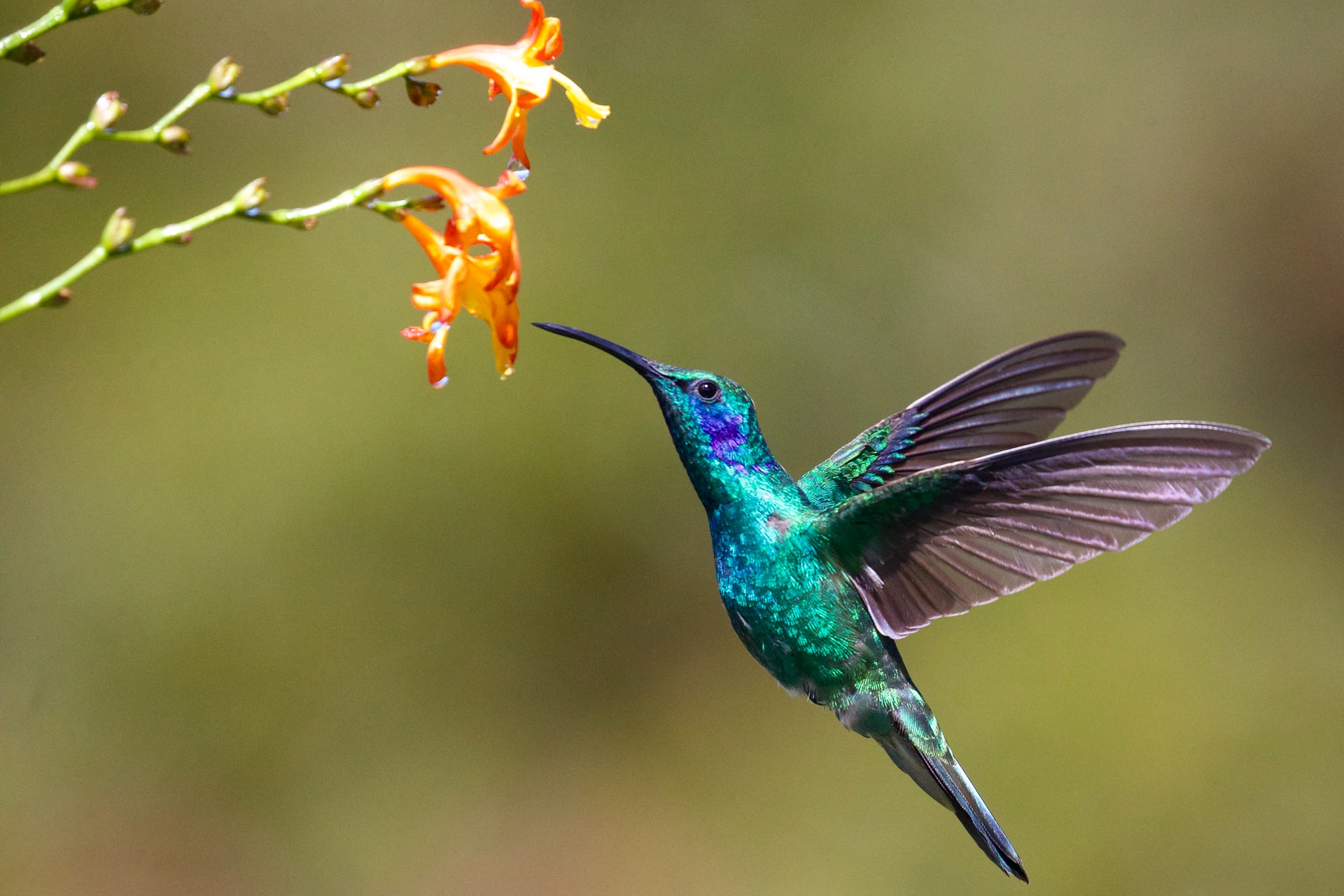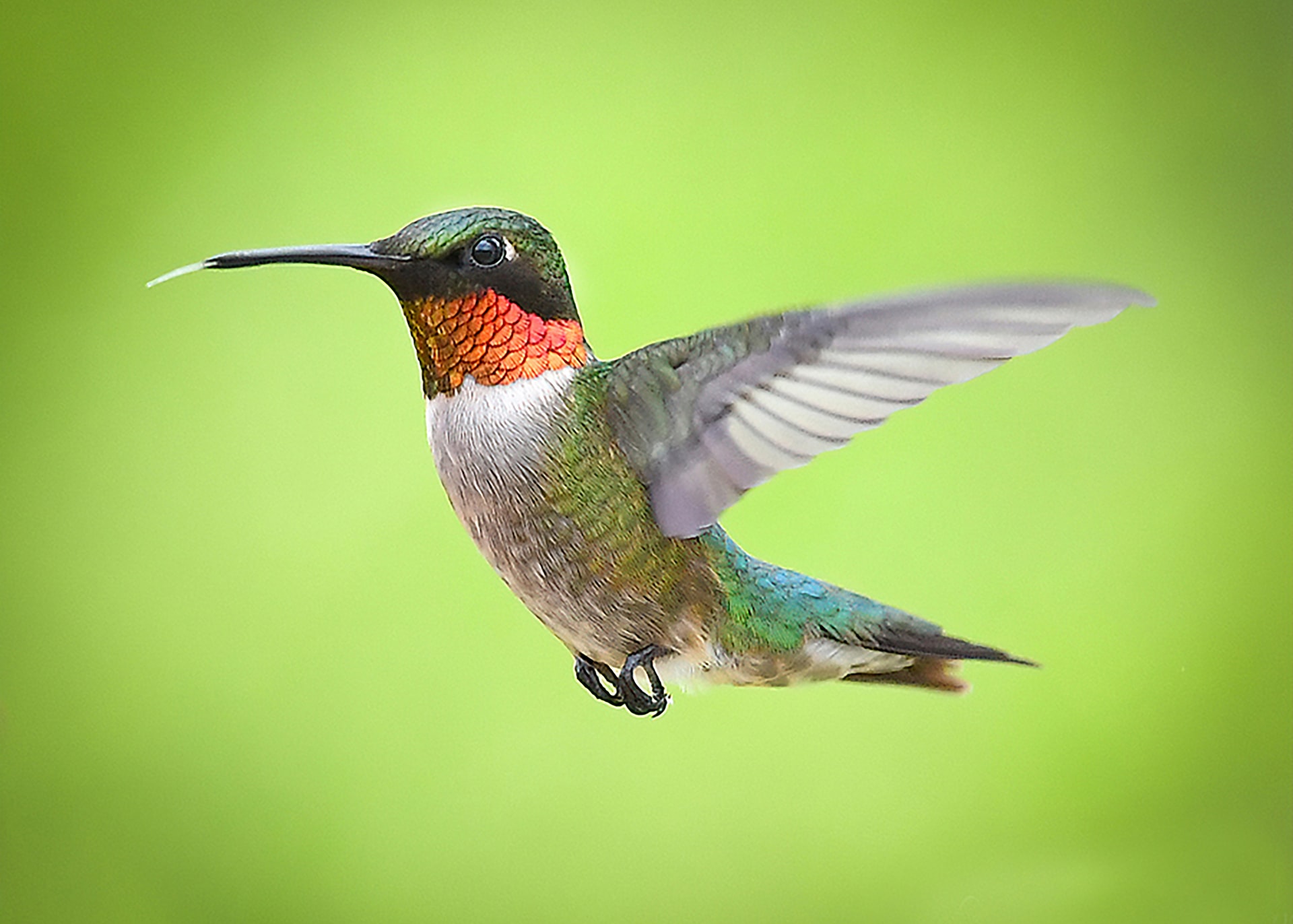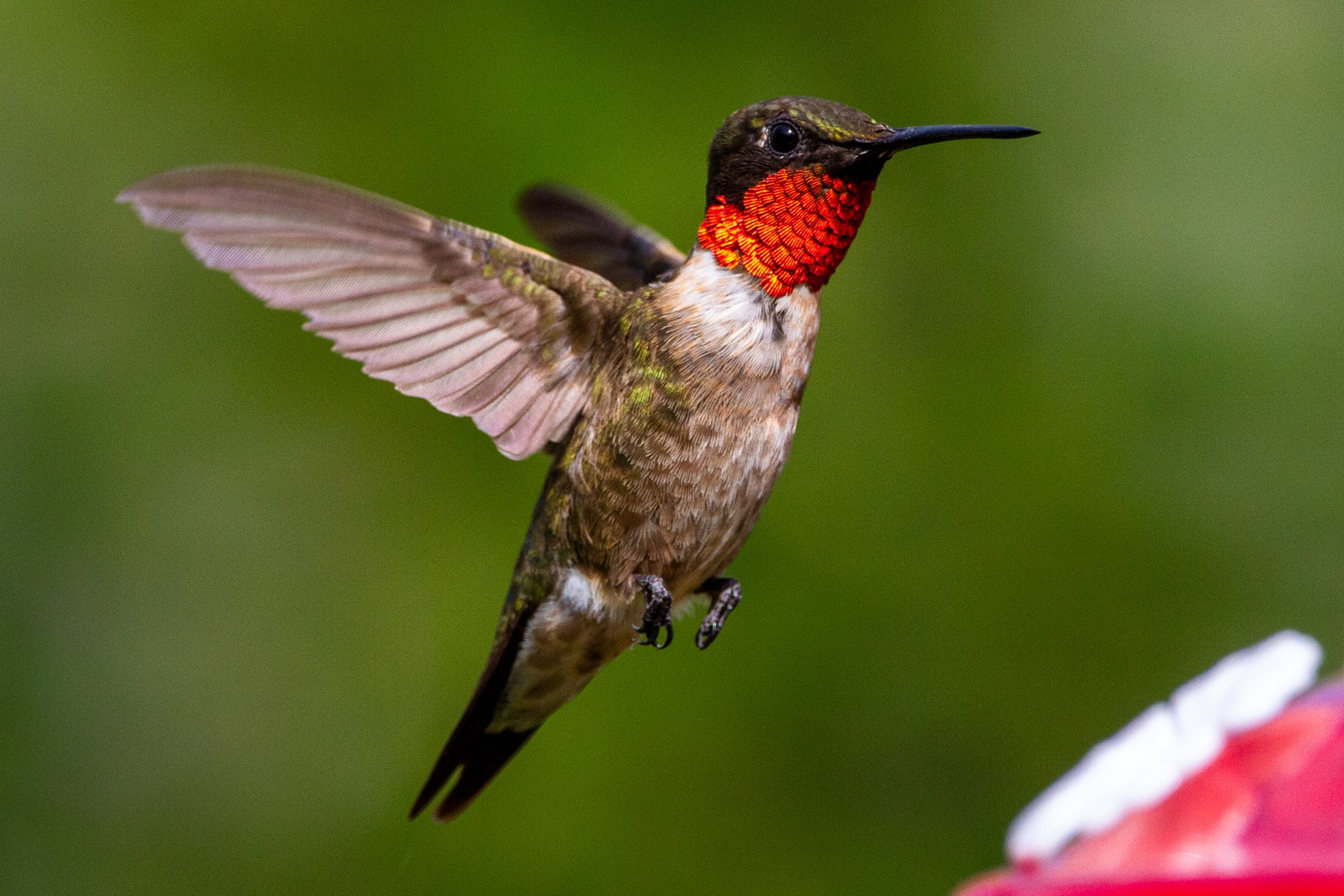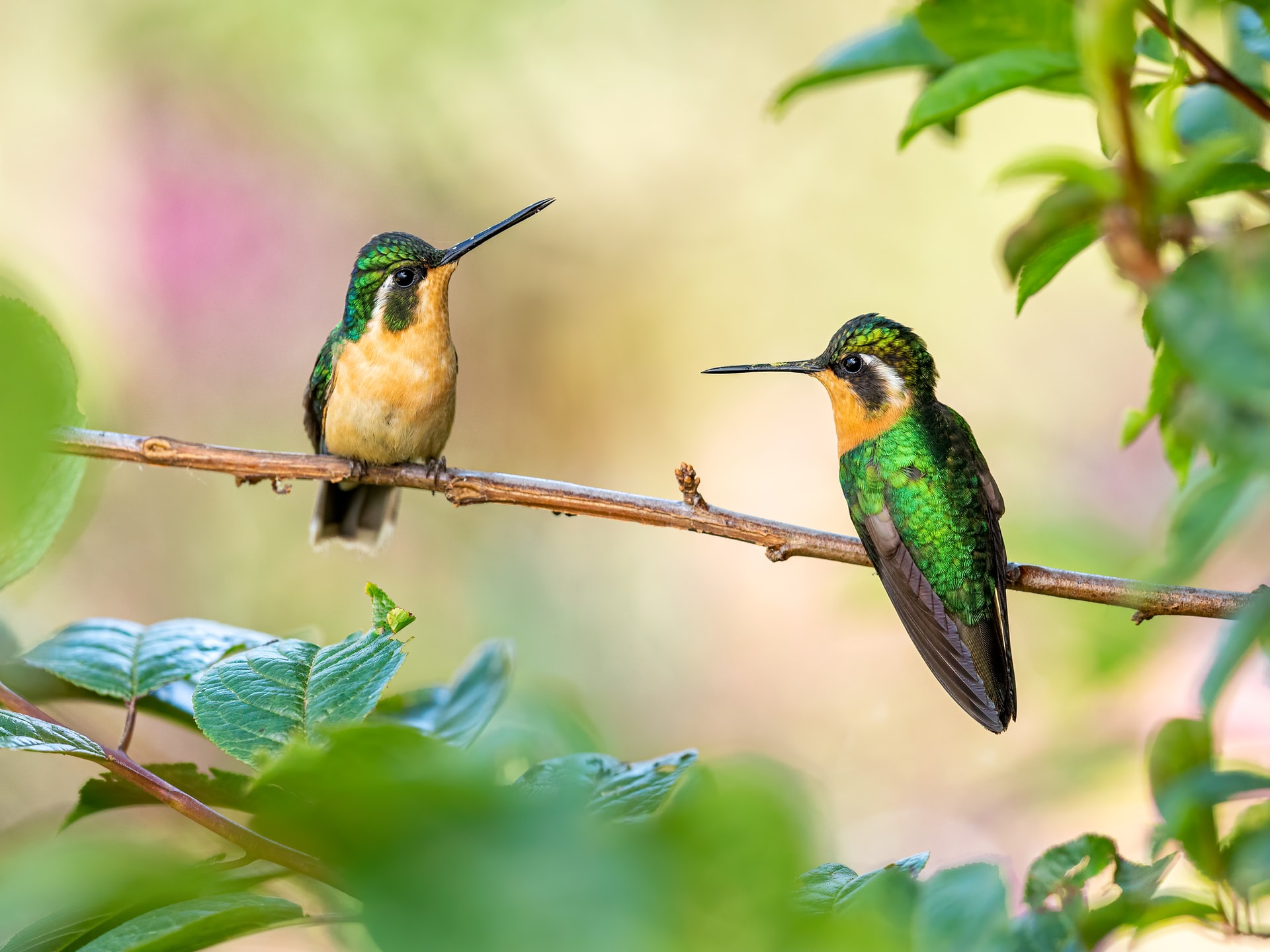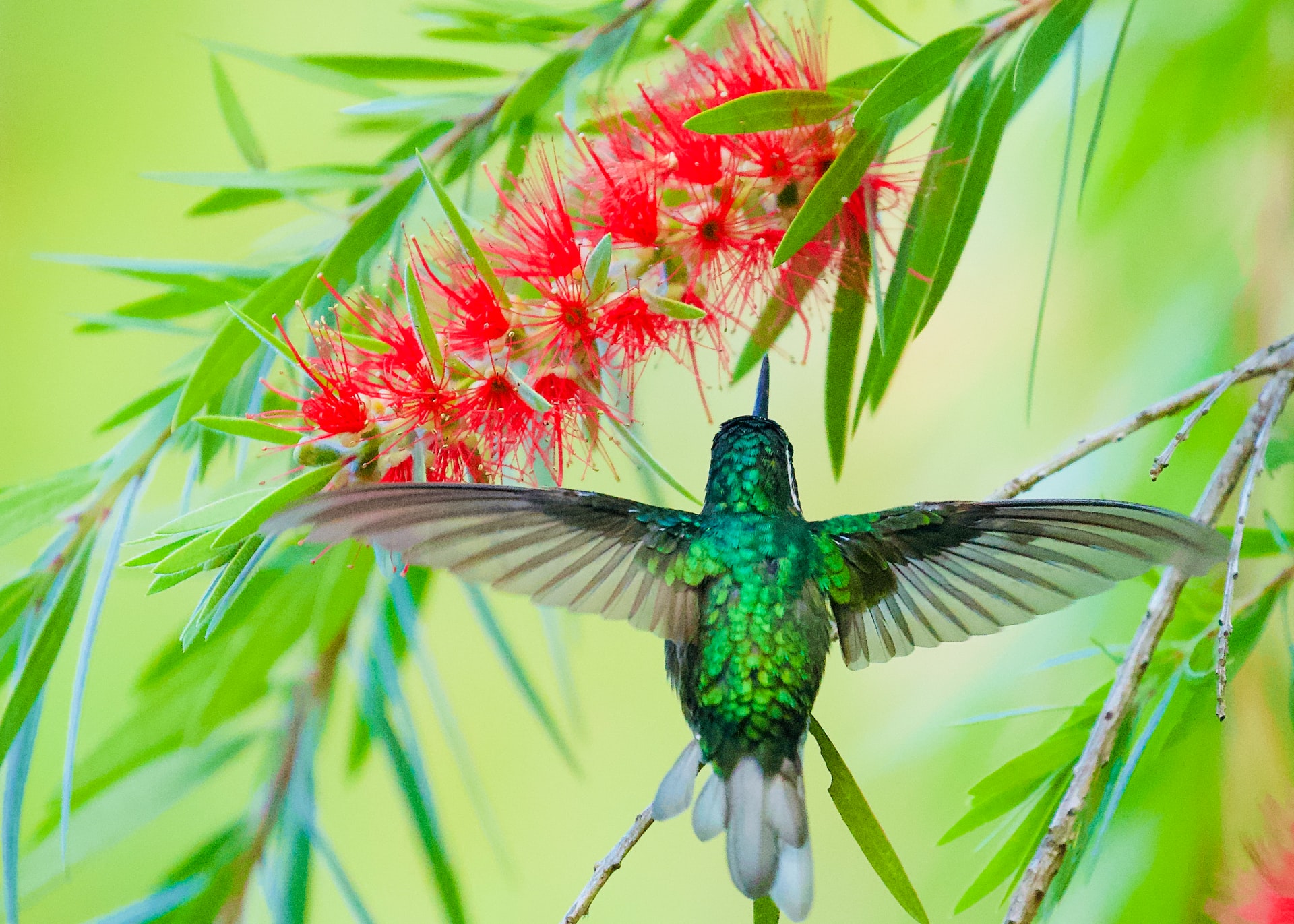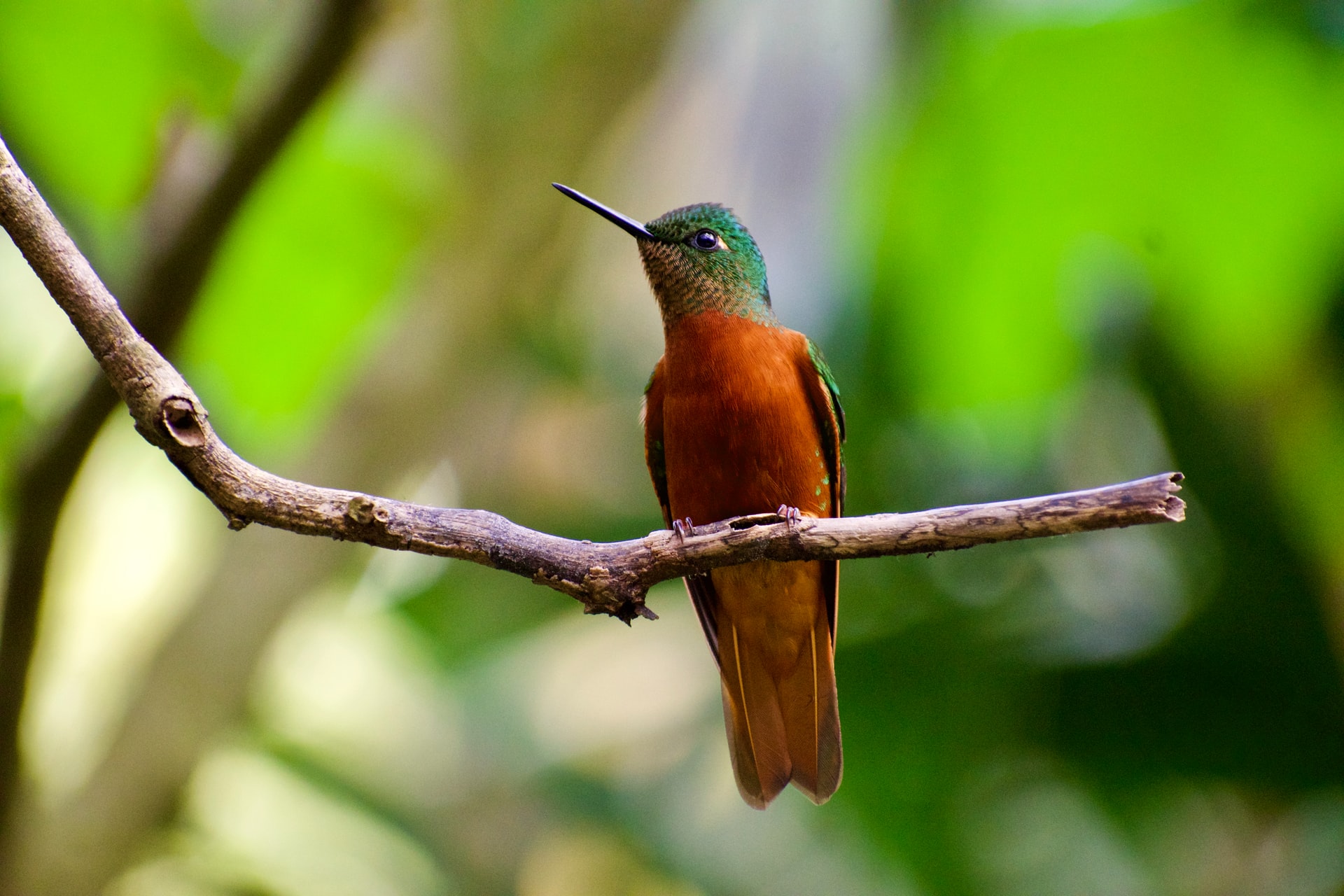- Amethyst-throated Mountain-Gem Guide (Lampornis amethystinus) - November 24, 2022
- Best Martin Bird House Guide - November 14, 2022
- Best Millet Bird Seed Guide - November 9, 2022
The magic of hummingbirds leaves me speechless whenever I have the privilege of seeing one. I love watching their busy bodies stop by my feeder for a sip of delicious sugar water as they go about what looks like a very busy day.
I am from Georgia, where Ruby-throated Hummingbirds are the only species of hummingbird to nest in the state. Needless to say, I feel intimately familiar with the species. The first time I placed hummingbird feeders in my backyard, I had no idea what to expect. I assumed I would get one or two visitors stopping by for a sip, right? Wrong! My yard became a hummingbird hotspot. I was underprepared for the amount of sugar water I would be stirring daily and felt a big responsibility to provide them with a 5-star feeder experience. That responsibility stuck with me, and I am rewarded with more and more Ruby-throated visitors each year.
These iridescent jewels are the only breeding hummingbird in eastern North America. If you’re focused enough, you can easily spot their small metallic green bodies moving quickly between food sources like flowers and feeders. The species is sexually dimorphic, and males display an iridescent ruby-red throat patch, also called a gorget, that can look black at different angles. Females have a dusky streaked white throat. Juveniles carry a similar resemblance to females until their dimorphic traits are established.
Taxonomy
The Ruby-throated Hummingbird is one of many hummingbird species, 339 to be exact. When Swedish naturalist Carl Linnaeus first saw one in South Carolina in 1758, he attributed it to the order Apodiformes, meaning “no feet.” This order was reserved only for hummingbirds and their closest relatives, swifts. Though we now know that they do indeed have feet, their quick movement made their feet hard to spot, so people commonly believed that the busy birds never stopped flying.
The Ruby-throated Hummingbird belongs to the family Trochilidae, meaning “small bird.” This family is specific to hummingbirds. Their genus, Archilochus, also includes the Black-Chinned Hummingbird (Archilochus alexandri).
How to Identify Ruby-throated Hummingbird
While it’s easy to recognize the apparent differences between male and female Ruby-throated hummingbirds, many features often go overlooked. The problem most birdwatchers have is that they are constantly moving so quickly that you can’t focus!
Ranging between 2.8 to 3.5 inches long, Ruby-throated hummingbirds have a wingspan of 3.1 to 4.3 inches. They typically weigh 2-3.5 grams and 6 grams when it is time to migrate. Females are larger than males by about 15-25%. Males have shorter bills, but they are still relatively long compared to their body length. A Ruby-throated Hummingbird’s bill makes up about one-fifth of their total body length.
Adults have a metallic green body with a greyish white chest and underside. Their wings are dark brown or black, and their long slender bills are 0.79 inches. Bills range from a dull to shiny black color. During spring seasons, pollen deposits can create a white or yellow discoloration of the bill. In both sexes, their eyes are dark brown with black pupils. A small patch of white feathers is located right behind each eye.
Adapted primarily for perching, Ruby-throated Hummingbirds have very short legs with three long front toes and one hallux in the back. Their toes have long curved nails and are grayish-black in color. Short legs prevent the bird from walking or hopping. They can shuffle across a perch and scratch their head and neck with their foot.
Let’s break down the significant differences between adult males, females, and juveniles so you can spot them quickly and confidently.
Adult Males
Any photos you may have seen of Ruby-throated Hummingbirds were most likely males. Their brilliantly colored throats make them extraordinarily photogenic and stun birdwatchers as their colors rapidly change with movement. Adult males feature a green crown, ruby-red gorgets, and a black chin and mask. They will have a notched and forked tail with pointed feathers that are a soft violet hue. You may need to watch males closely before seeing the color of their throats shift from black or dark red to magnificent reds and oranges. If you view them from the side or below, their throat will usually appear black. This can lead to misidentification.
Adult Females
Females are larger and feature outer tail feathers that are green, black, and white. They appear more earthy in their feather tones than males. A golden-green crown is met with a white throat and underparts. Sometimes their throat or chest may have grayish streaks or striping. Females have bluntly rounded tails with brownish-green tail feathers accompanied by white tips. Their tails are longer than their wings when folded.
Juveniles
Juvenile males have similar coloring to females and usually have more prominent throat markings. Brownish edges along the feathers are common for both juvenile males and females. During late summer, adolescent males will display one or two red throat feathers before their first winter, which is when they begin to show full male plumage around the throat. It is hard to identify the differences between young males and females until this point.
Vocalization
When you want to identify this hummingbird by their vocalization, listen for a series of rapid, squeaky, and monotonous chirps throughout their distribution areas at daybreak. When chasing one another, a fast-moving “chee-dit” is exchanged. Listen out for wings that make a humming sound. This sound has a higher pitch in males.
Where Does Ruby-throated Hummingbird Live Habitat
Ruby-throated Hummingbirds can be found throughout the woodlands of the eastern United States and in southeastern Canadian prairies. Where you can spot them depends heavily on their breeding and migration habits. Their optimal habitats are deciduous forests, backyard gardens, citrus groves, meadows, and orchards.
Ruby-throated Hummingbird Migration Patterns
As cold weather makes its way to the North American east coast, Ruby-throated Hummingbirds migrate to Florida, southern Mexico, and Central America to spend the winter in the sunshine. They have even been documents migrating as far as western Panama and the West Indies. Wherever they choose to spend the winter, Ruby-throated Hummingbirds must ensure there is a thriving ecosystem of flowering plants. In September, you will find Ruby-throated Hummingbirds throughout Louisiana or Texas before they make the 900-mile voyage across the Gulf of Mexico.
The lengthy non-stop flight over water is possible by their migratory diet preparations with the aim of doubling their weight. The flight takes an average of 20 hours in which the entire fat reserve is used.
Ruby-throated Hummingbird Diet and Feeding
It will likely come as no surprise to you, a bird enthusiast, that hummingbirds love to feed on nectar from flowers and flowering trees; but did you know they also require vitamins, fats, protein, and minerals from small arthropods such as ants, aphids, gnats, fruit flies, beetles, mites, and mosquitos? So while they are not only stunning creatures to watch from your backyard, they are also hard at work eating pesky critters that buzz around your ears.
When a Ruby-throated Hummingbird aims to catch a meal in the form of creepy-crawlies (I’m talking about insects!), they will scour through flowers and trees and even catch them on their wings. They sometimes visit spiderwebs to steal the catch of the day and any straggling insects that have been captured (rude, huh?).
Arthropods comprise most of the diet for young hummingbirds because nectar is not an adequate source of nutrition during their first month of life.
An arthropod diet provides essential proteins to aid Ruby-throated Hummingbirds. These proteins are used in preparation for migratory flights by doubling their weight from 3.5 grams to 6 grams, building muscle, and growing feathers.
Another hummingbird food source that is not generally known is sapsucker wells. North American woodpeckers aid the process by drilling small holes in the base of trees that fill with sap. These sapsucker wells make easy work of hunting small insects like ants, gnats, and flies that are easily attracted to the sugary tree sap. Two snacks in just one stop!
When it is sweet nectar the Ruby-throated Hummingbird is after, they display a preference for red, orange, and pink tubular flowers. Their long bills conceal an even longer extendable forked tongue that reaches deep into flowers. They flick their tongues nearly ten times per second while drinking the flower’s nectar.
Scientists studying the birds believe that 19 species of plants native to the eastern United States have evolved alongside hummingbirds. The tubular shape of specific flowers and the length and shape of the hummingbird’s bill can be no coincidence. As they forage, hummingbirds collect pollen on their feathers and bills. Because of this, scientists have compared the pollinating power of a hummingbird to that of a honey bee.
Attracting Ruby-throated Hummingbirds
If you live within the distribution range of Ruby-throated Hummingbirds and would like to attract the dazzling jewels to your backyard, consider adding the following plants to your garden:
- Trumpet Creeper
- Cardinal Flower
- Honeysuckle
- Jewelweed
- Lemon Beebalm
- Scarlet Beebalm
- Wild Bergamont
- Red Morning Glory
- Red Buckeye
Ruby-throated Hummingbirds benefit from the sugar water dedicated bird lovers kindly place out for them. Homemade nectar provides them with energy quickly. They also enjoy eating the small insects that are enticed to have a drink themselves.
Incorporate a water feature or simple bird bath into your yard. Hummingbirds enjoy taking a dip several times a day, and a fountain or bath is sure to attract a few visitors. Refill with fresh water daily to keep them coming!
Place several feeders in varying shady locations so the hummingbirds can avoid one another. A few dominant personalities in the bunch always take over the feeder, prohibiting others from enjoying your hard work.
Are Hummingbird Feeders Bad for Hummingbirds?
I live a nomadic lifestyle that primarily consists of parking my tiny camper on public land throughout national forests (it’s relevant, I promise). While bird watching one morning, I noticed a fellow camper had a hummingbird feeder out. It had not occurred to me that placing a feeder in a mostly uninhabited area would be okay. I was worried that supplying them with nectar would be irresponsible since I cannot do so consistently. After researching, I learned that the feeders filled with sugar water only act as a supplemental nectar source. These feeders are especially helpful during seasons when flowering plants are hard to come by. Feeding hummingbirds will not harm their migratory patterns or cause them to become dependent on the feeder.
The Do’s and Don’ts of Hummingbird Feeders
Here are a few guidelines to observe to ensure your hummingbird feeder is responsible and safe:
- Do Not Use Red Coloring: Chemical dyes and food colorings used in store-bought hummingbird nectar are not necessary and are harmful to the birds. Instead, save money and hummingbirds by making your own nectar. Use a 1:4 solution of refined white sugar to tap water. Bring to a boil and allow the solution to reach room temperature before filling your feeder. Do not use brown sugar, honey, or molasses. These have sweetening agents that can be harmful to the birds.
- Keep Your Feeder Clean and Fresh: Clean your feeder twice weekly in hot weather and once per week during cooler temperatures. Ditch the soap. Dish soaps leave a harmful residue that can be easily avoided by imploring either hot water or a weak vinegar solution. Hang feeders in the shade to prevent fermentation of the sugar water in hot temperatures. Replenish or replace sugar water two times per week. One or two insects on the feeder are not an issue, but when it becomes overtaken by ants, it’s time to clean the feeder and relocate somewhere less accessible to ants.
- Bring Feeders Inside During Freezing Temperatures: Avoid supplying hummingbirds with frozen sugar water by bringing feeders in overnight. They will appreciate having room temperature sugar water early in the morning, especially during colder months when natural nectar sources are scarce.
Ruby-throated Hummingbird Breeding
While some of the birds you read about on our site mate for life, Ruby-throated Hummingbirds are of a different mindset. Ruby-throated Hummingbirds do not form breeding pairs and prefer a solitary lifestyle, only interacting during the breeding season. They are primarily polygynous birds with some polyandry and polygynandry observed. What does all that mean? Here’s a quick breakdown of how those terms relate to Ruby-throated Hummingbirds:
- Polygynous: one male hummingbird mates with several females.
- Polyandry: one female hummingbird mates with several males.
- Polygynandry: both the male and female hummingbird will take serval mates.
Polygynous behavior is most common and advantageous to the species due to a more significant number of adult females than males.
After a warm winter in Florida, Mexico, or Central America, male Ruby-throated Hummingbirds return to the United States and Canada around late March. Within a week, females will begin returning also. This gives males a head start to establish breeding territories and defend them. Once the females arrive, males perform courtship flights to catch the eye of as many ladies as possible. This courtship flight is more of a dive and consists of flying eight to ten feet upwards, diving within five to six feet on either side of the female. It looks like a U-shaped pattern and is particularly loud if you’ve been lucky enough to see the performance. A fast chirping or chittering can be heard, and a quick “zoosh” sound accompanies their dramatic dives.
Once the male has enticed a female with his energetic courtship display or security of a top-notch feeding ground, she will give a call and perch herself with raised tail feathers and dropped wings to invite the mating process to commence. The male will repeat this process with several other females and leaves quickly after mating. The female assumes responsibility for, well, everything else.
Ruby-throated Hummingbird Nesting
After mating with her chosen male, the female Ruby-throated Hummingbird spends her time selecting a suitable nesting site. Preferred sites are typically on a downward sloping tree branch in a deciduous tree such as oak, birch, poplar, hornbeam, hackberry, and sometimes pine. Competitive sites are located over a stream or open area. When these sites are not available, a large horizontal limb will do.
The nesting materials used are lichen, spider webs, and plant down from dandelions or thistles. If you have attracted a hummingbird to your yard, try hanging a nesting ball filled with pet hair or scattering it around the yard. No need to let it go to waste on your sofa cushions! Old nests will be repaired and reused for many seasons.
As the necessary materials are collected, the female spends many hours constructing a small nest about 4 centimeters wide by 6 centimeters tall. Lichen is placed outside the nest to provide proper camouflage from pesky predators. The plant down acts as a liner for the inside of the nest to make a cozy cup, perfect for the small birds she will raise.
Ruby-throated Hummingbird Eggs
Once her nest is skillfully constructed, the female lays white eggs, the size of a pea, about 8 millimeters by 13 millimeters. Commonly, the female will lay one to two eggs, rarely three, as this is too many chicks for the female to care for successfully.
The incubation period for Ruby-throated Hummingbirds is 14-21 days, with 16 being average. The female will incubate her eggs most of the day except for about 5 minutes per hour. Once born, the naked chicks have short bills and cannot keep themselves warm. The responsibility to warm and feed the nestlings falls on the mother as she tactfully leaves the nest to gather food. While the male is not present throughout this process, he will allow the female to access his feeding ground (where the breeding took place), so she may minimize her time away from the nest. Pollen, nectar, and small insects are the primary food source collected for the nestlings. The female will regurgitate a blend of these into the mouths of her chicks one to three times every hour.
On day three of the chick’s life, they have doubled in size. Their size will continue to double by day five and again on day eight. Talk about growing up quickly! On day eight, small feathers begin forming on the naked skin of the growing chicks. Once they have been in the nest for about three weeks, the chicks fledge and start taking care of themselves.
Ruby-throated Hummingbird Population
It is always lovely to write about birds with happy and healthy populations. The Ruby-throated Humming is one of those! With a population of over 7 million individuals, the species has a conservation status of Least Concern with a rising population.
Is Ruby-throated Hummingbird Endangered?
The Ruby-throated Hummingbird is not endangered. However, in the early 19th century, humans often hunted them for their gorgeous feathers. Protection came from the Migratory Bird Treaty Act, which prohibited poaching or possessing migratory birds. Ruby-throated Hummingbirds are also listed in Appendix II of the Convention on International Trade in Endangered Species of Wild Flora and Fauna of 1975 (CITES). This classification means that the species is not threatened or extinct, but trade needs to be controlled to avoid behavior that could prove detrimental to the species.
The best way you can protect your local population of hummingbirds is to plant and protect nectar-rich plants along their migration routes.
Ruby-throated Hummingbird Habits
These small but mighty birds are known for their ability to hover in flight. When we observe this behavior at feeders, it is mind-boggling! How are they so still while moving so fast? Well, they beat their wings an astonishing 60-80 times per second. Their short humerus or main wing bone is adapted to aid the hovering process. When paired with large deltoid-pectoral muscles, this gives them the ability to have high wingbeat frequencies. Their wings connect to their tiny bodies with large muscles at the shoulder, which gives their wings 180 degrees of rotation. This wing rotation allows them to fly backward and hover in mid-air, similar to insects.
Ruby-throated Hummingbird Predators
Ruby-throated Hummingbirds are not excluded from being a part of the food chain even though they are small and fast. Their predators, however, are not who you’d expect. Let’s start with the most obvious, other birds. Predatory birds like the sharp-shinned hawk, American kestrel, merlin, and Mississippi kites can easily target hummingbirds. These are all fast-moving birds that can keep up high-speed flight times for an extended period.
Now, let’s delve into the less suspecting predators of the Ruby-throated Hummingbird. First up, dragonflies. While some information on the internet says it is just hearsay, photos capturing the behavior have convinced the majority that this insect indeed poses a real predatory threat.
Next up are spiders. Spiders aren’t necessarily hunting Ruby-throated Hummingbirds as much as the birds are just getting caught in their deathly webs. During the nest-building process, they steal silk from spiders and are also observed scavenging insects from spiderwebs. This behavior, while essential to their means of survival, can lead to their death when they become entangled themselves.
Praying mantids are carnivores that can hunt hummingbird feeders waiting for the Ruby-throated Hummingbird to take a drink. You may think that mantids are significantly smaller than hummingbirds, but they are actually the same length. A hummingbird is a super-sized meal for a praying mantis, but hummingbirds are not off the menu when a mantis is experiencing extreme hunger. You rarely encounter this issue with your hummingbird feeder, but placing it away from shrubbery and trees will make this effort harder for the praying mantis. Never use insecticides on or near feeders. You can also use a stick to relocate the mantis.
Bullfrogs have been known to eat small birds. The Ruby-throated Hummingbird is no expectation. These large frogs will lunge from the water to snatch and eat hummingbirds; however, the perfect storm must be created to facilitate the catch. To avoid this horror scene in your yard, do not place feeders directly above ponds or streams where frogs enjoy hunting.
Nest predators looking for an easy meal while mom is out hunting include squirrels, blue jays, bats, and chipmunks.
Ruby-throated Hummingbird Lifespan
Much of the information we have about Ruby-throated Hummingbirds come from banding practices used to observe their behaviors, migratory patterns, and lifespan. The oldest banded Ruby-throated Hummingbird was a nine years old female. The average life span is between three and five years old, with most deaths occurring within the first year of life. Their life expectancy dramatically increases when they make it through their first year and migratory cycle.
FAQ
Answer: Place feeders in your yard and keep them full of a 1:4 ratio solution of refined white sugar to tap water. Aim to plant orange, pink, and red tubular flowers in your garden to attract hummingbirds. Also, consider planting beebalm, honeysuckle, trumpet creeper, bergamot, and cardinal flower.
Answer: Yes, hummingbirds have incredible memories. Their brains make up around 4% of their body weight. They remember things about their environment, like how long before the flowers they enjoy visiting refill with nectar and who the humans are that refill their bird feeders.
Answer: Hummingbirds are sexually dimorphic, meaning the males are smaller than the females by 15 to 20%. Males display bright ruby-red throats that appear black when viewed at certain angles. Females have buffy white underparts and do not have brightly colored chests. You can also tell the sexes apart by their tail feathers. Males will often display pointed tail feathers while females display rounded tail feathers.
Answer: Fast! Ruby-throating Hummingbirds beat their wings anywhere from 60-80 times per second during routine flight and up to 200 times per second when performing courtship dives.
Answer: Ruby-throated Hummingbirds’ in-flight speeds average around 25 mph and up to 40 mph during courtship dives.
Answer: When resting, a Ruby-throated Hummingbird’s heart beats about 250 times per minute. When flying, their heart beats about 1,220 beats per minute! Similarly, they take about 250 breaths per minute while resting.
Research Citations
Cornell Lab of Ornithology. (n.d.). Ruby-throated Hummingbird. All About Birds. Retrieved June 25, 2022, from https://www.allaboutbirds.org/guide/Ruby-throated_Hummingbird/overview
Ruby-throated Hummingbird. (n.d.). Hummingbird Central. Retrieved June 25, 2022, from https://www.hummingbirdcentral.com/ruby-throated-hummingbird.htm
Coevolution Institute. (n.d.). Ruby-throated Hummingbird. U.S. FOREST SERVICE. Retrieved June 25, 2022, from https://www.fs.fed.us/wildflowers/pollinators/pollinator-of-the-month/ruby-throated_hummingbird.shtml#:%7E:text=Some%20hummingbird%20favorites%20include%20native,trumpet%20creeper%20(Campsis%20radicans).
Looking for more interesting readings? Check out:


